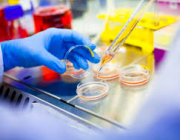Badis DAIKH.
Comparative study of the therapeutic efficacy of autologousplatelet-rich plasma and honey in healing skin wounds in sheep. veterinary wourd. 2021;14 (8).
AbstractBackground and Aim: This investigation is the continuation of a published preliminary study examining the therapeutic
efficacy of platelet-rich plasma (PRP) as a topical treatment for skin wounds in sheep. The study aimed to compare the
healing effects of autologous PRP with that of natural honey.
Materials and Methods: This study involved nine clinically healthy male sheep. After sterile skin preparation, fullthickness
longitudinal incision wounds were created on the backs of each animal. The animals were randomly divided into
three groups of three sheep each. In Group I, the wounds were treated with PRP; in Group II, the wounds were treated with
honey; and in Group III, the wounds were treated with saline solution. The different treatments were administered topically
every 3 days. Healing was assessed by a semi-quantitative histopathological study from biopsies taken on the 3rd, 7th, 14th,
21st, and 28th days of healing. The data obtained were compared using the non-parametric Mann–Whitney U-test, and p<0.05
and 0.01 were used to determine the level of significance of the recorded differences.
Results: Semi-quantitative histopathological evaluation showed significant differences in the progression of wound healing
between the three study groups. Recorded data showed that PRP may reduce inflammation during the first 3 days after the
incision. Moreover, the synthesis and organization of collagen fibers were significantly improved in the group treated with
PRP compared with those in the group treated with honey.
Conclusion: PRP offers a promising therapeutic option for healing skin wounds in sheep compared with honey.
Keywords: honey, platelet-rich plasma, sheep, skin, wound healing.
 25_01.pdf
25_01.pdf 